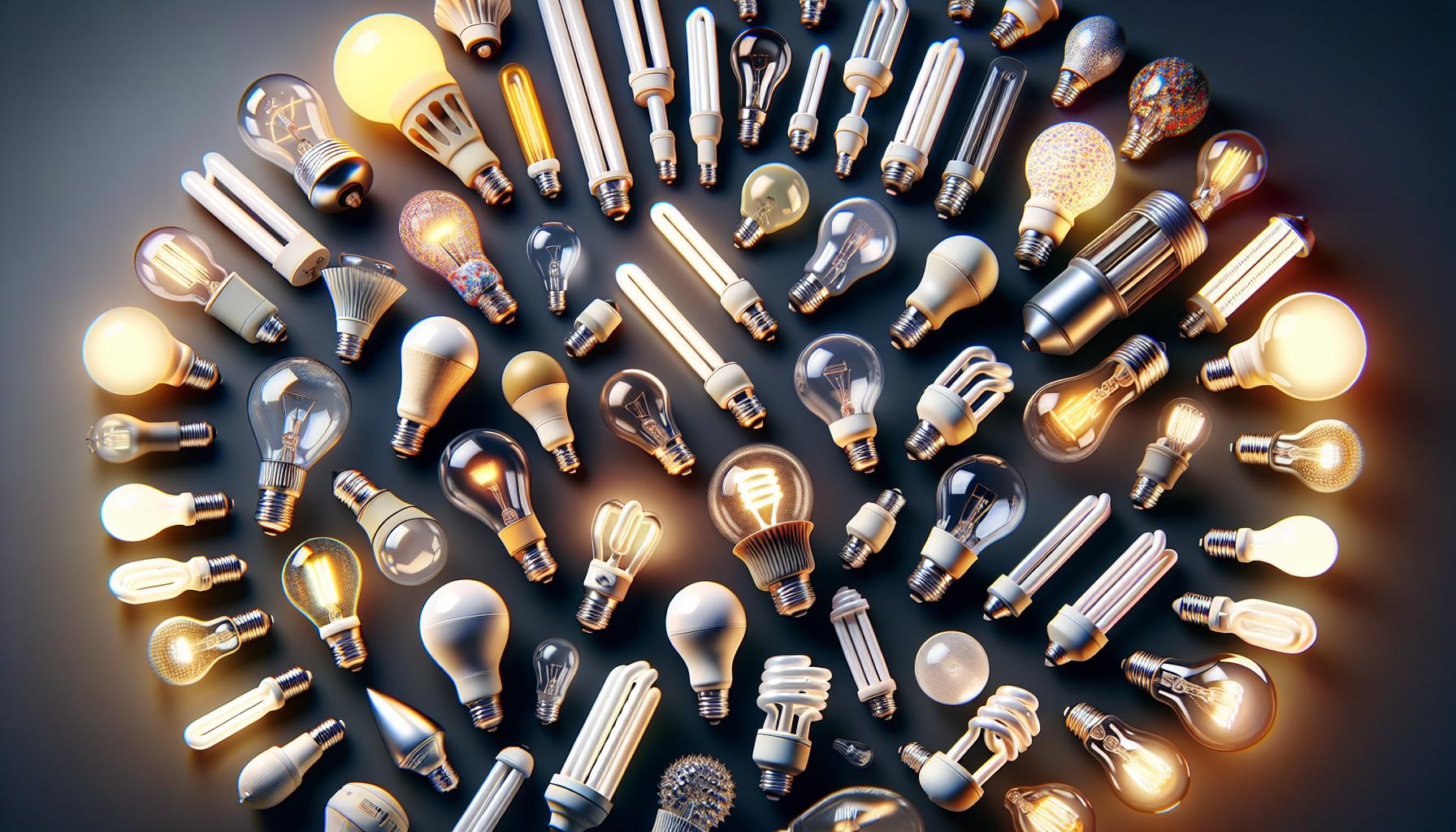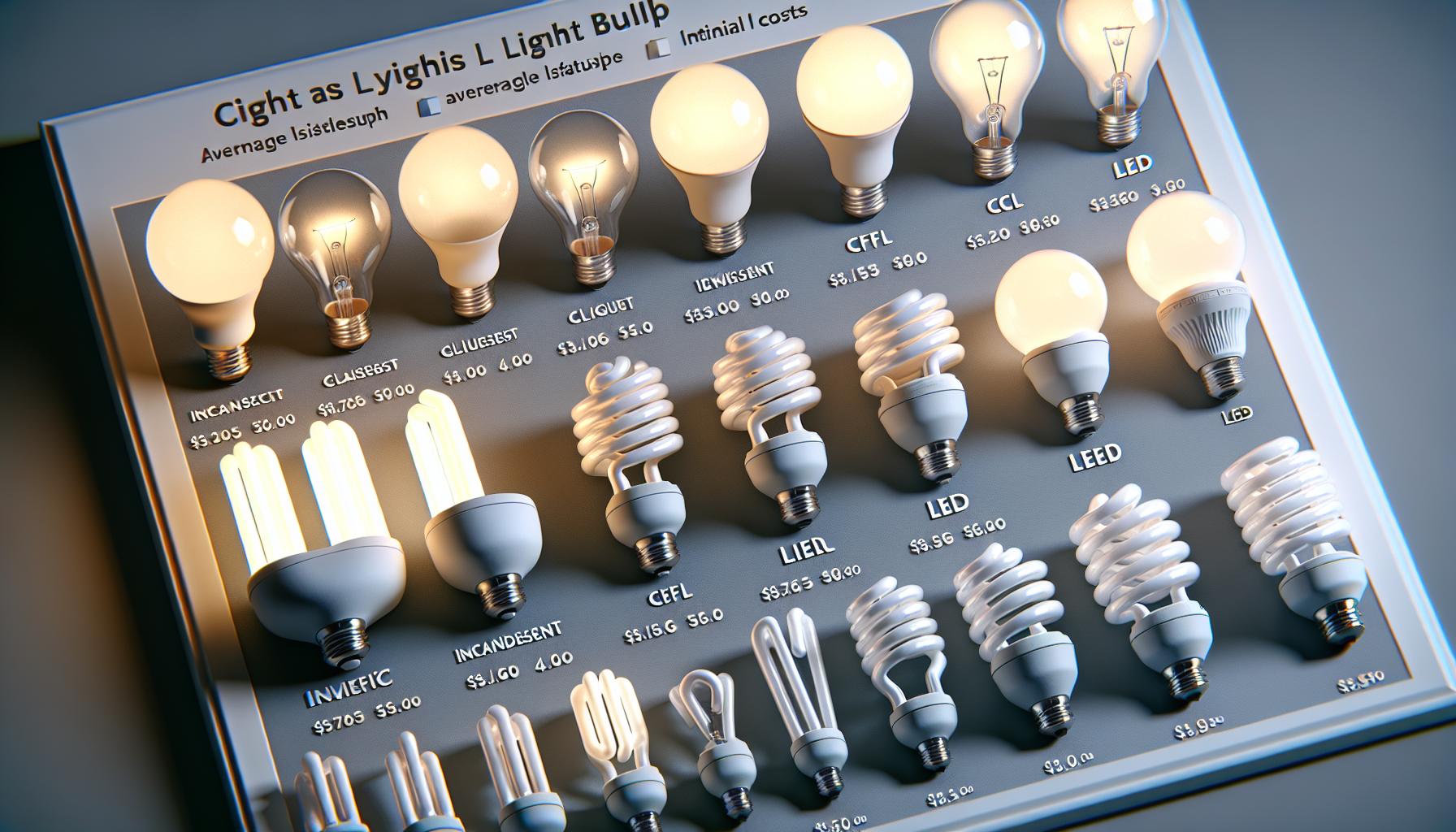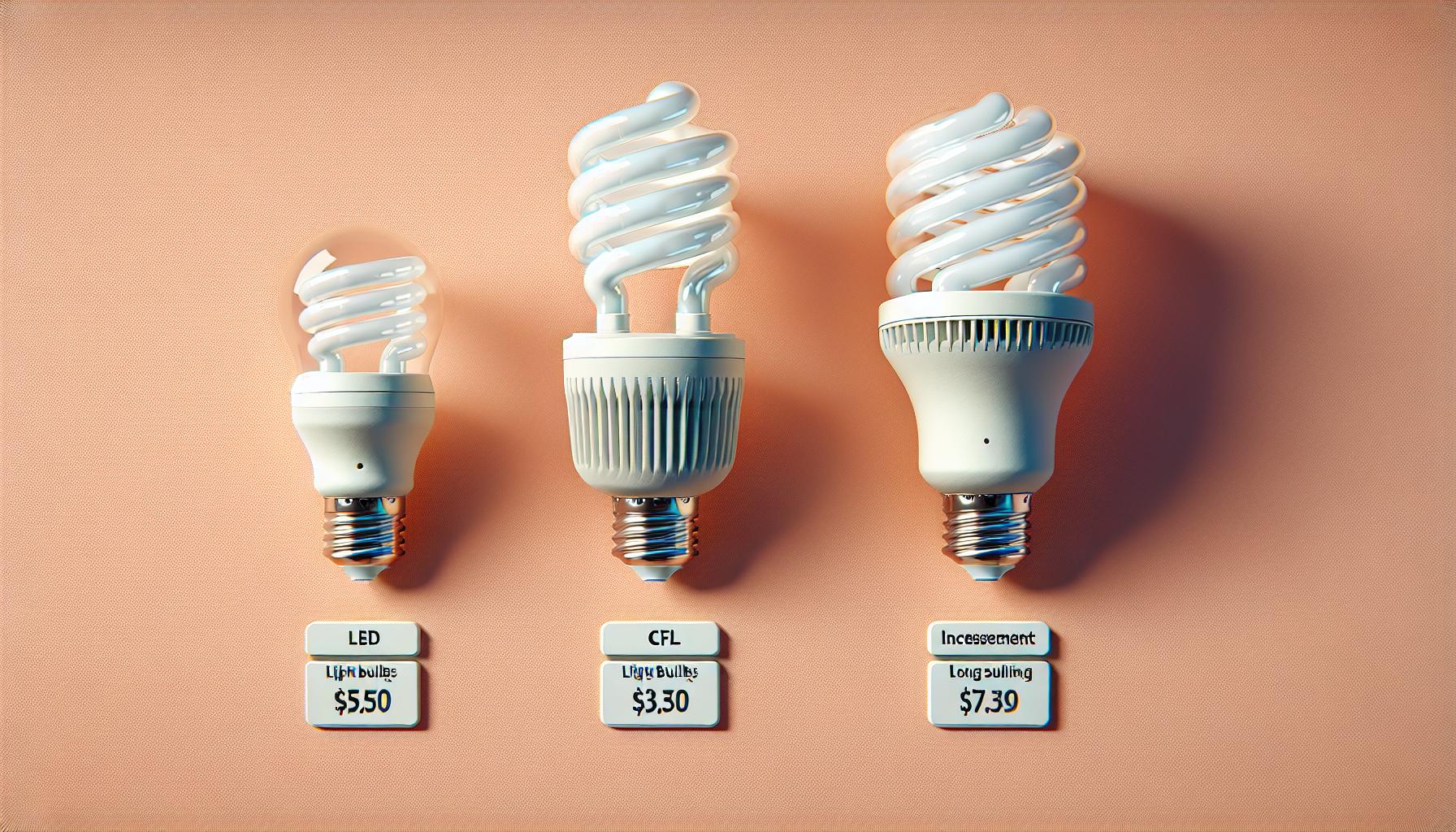Ever found yourself standing in the light bulb aisle, bewildered by the array of choices and prices? You’re not alone. Replacing light bulbs is one of those household tasks that’s as inevitable as it is varied in cost.
From the classic incandescent to the modern LED, each bulb type comes with its own price tag and lifespan. You’re about to discover what factors into the cost of replacing your home’s light bulbs and why investing in certain types could save you money in the long run.
Let’s shed some light on the subject and help you navigate the cost of keeping your home bright and welcoming.
Understanding Light Bulb Types
When you’re in the aisle contemplating the plethora of light bulb options, it’s crucial to understand the differences beyond just the initial price tag. From the traditional glow of incandescent bulbs to the tech-savvy LEDs, each type of bulb has its unique characteristics and cost implications over its lifetime.
Incandescent bulbs are the old-school choice, often favored for their warm light. They’re also the least expensive upfront, but they’re not the most economical in the long run. High energy consumption and a shorter lifespan mean you’ll be replacing and paying more over time.
Transitioning to LEDs might feel like a leap, but they’re leading the pack for a reason. With a lifespan that can stretch up to 25 times longer than incandescent bulbs, and energy efficiency that could save you about 80 percent on your electricity bills, the initial investment quickly pays off.
Don’t overlook compact fluorescent lamps (CFLs). Straddling the line between incandescent and LED, CFLs offer a decent lifespan and energy savings. Just remember that they contain mercury, so you’ll need to handle them with care and dispose of them properly.
Finally, halogen bulbs might catch your eye as a bright choice. They are a type of incandescent that uses less energy and lasts longer. Still, they don’t hold a candle to the longevity and efficiency of LEDs.
Each bulb type brings something to the table, but it’s your call to decide what’s best for your home and wallet. Factor in the energy use, lifespan, and price of each bulb type with your personal preferences and you’re well on your way to making an informed decision. Remember, lighting is not just about illumination; it’s about setting the mood, saving on costs, and minimizing your environmental footprint. With a little knowledge, you’ll light up your home efficiently and beautifully for years to come.
Factors Affecting the Cost of Light Bulbs
When considering the cost to replace light bulbs in your home, you’ll quickly find that prices can vary widely. The initial sticker price is only part of the story, as different types of light bulbs bring with them different cost implications over time.
Type of Bulb
The type of light bulb you choose is perhaps the most significant factor determining upfront costs and long-term expenses. Here’s what you need to know:
- LED bulbs: Although they can be more expensive initially, their energy efficiency and long lifespan make them a cost-effective option over time.
- Incandescent bulbs: These are usually cheaper upfront but cost more in the long run due to higher energy consumption and frequent replacement.
- CFLs: These strike a balance between cost and efficiency, but you may have to deal with the additional cost and hassle of proper disposal due to their mercury content.
- Halogen bulbs: They’re brighter and more energy-efficient than traditional incandescents, but they tend to be pricier and can run hotter.
Wattage and Lumens
Wattage and lumens relate directly to the energy use and brightness of a bulb, both of which affect cost. Higher wattage bulbs use more electricity, so you’ll see a higher cost on your utility bills, whereas the lumens tell you how bright the bulb is—the more lumens, the brighter the light, which may translate into buying fewer bulbs.
Brand and Quality
Not all light bulbs are created equal. You’ll find that premium brands often offer longer warranties and are presumed to have better longevity and performance. Investing in a higher-quality bulb can mean fewer replacements and better reliability, affecting overall costs.
Features and Technology
« What Kind of Light Bulbs Are Yellow? Discover Cozy Lighting Secrets
What Light Bulbs Have Yellow Light? Create a Cozy Home Glow »
Some light bulbs come with advanced features like dimming, color-changing capabilities, and smart technology integration. While these enhancements provide greater control and customization, they also bump up the price.
Remember, the longevity and feature set of a bulb can significantly offset the initial cost outlay. As a DIY enthusiast and lighting aficionado, always consider the long-term implications of your home lighting choices. After all, the right light not only illuminates your space but also your life.
Comparing Incandescent, CFL, and LED Bulbs
When you’re deciding between incandescent, CFL (Compact Fluorescent Lamp), and LED (Light Emitting Diode) bulbs, you’ll want to weigh several key factors: energy efficiency, cost, and lifespan.
Incandescent bulbs are the old standbys. However, they’re not as energy-efficient as their modern counterparts. They typically last about 1,000 hours and are cheaper upfront, but they’ll cost you more in the long run due to higher energy consumption.
CFLs were introduced as a more efficient alternative, using about 70% less energy than incandescent bulbs. They have a longer lifespan, around 8,000 to 10,000 hours, which means less frequent replacements. While they’re pricier than incandescents, you’ll see the cost benefits over time with energy savings.
LED bulbs are the front-runners in energy efficiency and longevity. They use about 75-80% less energy than incandescent bulbs and can last for an impressive 20,000 to 25,000 hours. This substantial increase in lifespan and decrease in energy use makes them the most cost-effective option over time, despite their higher initial price tag.
Here’s a quick breakdown of average costs and lifespans:
| Bulb Type | Average Lifespan (hours) | Average Cost (initial) |
|---|---|---|
| Incandescent | 1,000 | $ |
| CFL | 8,000 – 10,000 | $$ |
| LED | 20,000 – 25,000 | $$$ |
Remember, these costs can vary based on brand and the specific features of the bulb. When it comes to features, LEDs offer the most versatility, including dimmable options and smart bulb capabilities that sync with your home automation systems.
Energy efficiency extends beyond just the type of bulb. Wattage and lumens are crucial as well; less wattage means less energy consumption, and more lumens mean brighter light. It’s essential to find the right balance for your needs.
Cost Analysis of Different Light Bulb Types
When you’re diving into the world of light bulbs, it’s smart to weigh the long-term costs as much as the sticker price. Sure, you may pay less upfront for some types, but what about the costs over time? Let’s break it down.
Incandescent bulbs are the old standbys, but they’re not too kind to your wallet in the long run. Their lifespan doesn’t just fall short compared to other options, but they also gobble up more energy, which means higher bills.
Compact Fluorescent Lamps (CFLs) sit comfortably in the middle. They last longer than incandescents and save energy too. But remember, they contain mercury, so you’ll need to handle them with care, especially when it’s time to say goodbye.
Light Emitting Diodes (LEDs) are the new kids on the block that are changing the game. They’re more expensive initially, yes, but they last an age and sip electricity rather than guzzle it. With LEDs, your investment pays off with fewer replacements and lower energy bills.
To give you a clearer picture, let’s look at the average cost per bulb type:
| Bulb Type | Average Cost per Bulb | Average Lifespan |
|---|---|---|
| Incandescent | $1.25 | 1,200 hours |
| CFL | $2.50 | 8,000 hours |
| LED | $5.00 | 25,000 hours |
Keep in mind that prices can vary based on features like dimming capabilities, color temperature, and brand reputation.
Now for the energy cost angle. It’s like watching a race where LEDs are miles ahead. For the energy it takes to run an incandescent bulb for 1 hour, a CFL will run for the same time on about 30% of that energy, and an LED will use only around 20-25%. Translate that into energy costs over the bulb’s lifespan, and you’re looking at considerable savings with LEDs.
Saving Money in the Long Run
When you’re delving into the world of lighting, you quickly learn that upfront costs don’t always paint the whole picture. Think about light bulbs as an investment. Sure, LED bulbs might pinch your wallet a bit more at the checkout, but they start paying for themselves in no time. LEDs stand out not just for their energy efficiency but also for their staggeringly long life spans.
It’s not all about the tag price; it’s about the cost per hour. LEDs can last up to 25 times longer than incandescent bulbs and 3 times that of CFLs. Imagine the savings from not needing to replace your bulbs as often. That’s fewer trips to the store and more money in your pocket.
Let’s crunch some numbers. Consider an LED bulb with an average lifespan of about 25,000 hours compared to an incandescent’s 1,000 hours. With a price tag that’s only a few times higher, but a lifespan 25 times longer, the math is clearly in your favor.
Here’s a snapshot of average lifespan and costs for a clearer picture:
| Bulb Type | Average Lifespan (hours) | Average Cost (USD) |
|---|---|---|
| Incandescent | 1,000 | $1.00 |
| CFL | 8,000 | $2.00 |
| LED | 25,000 | $8.00 |
Beyond the lifespan and energy consumption, consider also the savings in time and inconvenience. Your DIY projects are much more rewarding when they’re not constantly being interrupted by the need to swap out a fried bulb. Switching to long-lasting bulbs means you set up your beautifully lit space and enjoy it, worry-free, for years.
Think about the implications for larger projects or commercial spaces where dozens, if not hundreds, of bulbs are in use. The aggregate savings from opting for the most efficient lighting solutions can be monumental. You’re not just saving pennies here and there; you’re contributing to a more sustainable energy footprint.
By now, you’re poised to make an informed decision that aligns with not only your budget but your values and time. So take this knowledge with you as you consider the long-term benefits next time you’re standing in the lighting aisle, pondering your options.
Conclusion
So there you have it! You’re now equipped with the knowledge to make a savvy choice when it comes to replacing your light bulbs. Remember, while the initial price tag for LED bulbs might make you pause, the investment pays off with impressive long-term savings and fewer replacements. It’s not just about the dollars and cents; it’s also about the convenience and the positive impact on the environment. So go ahead, weigh your options and choose the bulbs that align with both your immediate needs and future benefits. Happy lighting!
Frequently Asked Questions
What types of light bulbs are discussed in the article?
The article discusses incandescent, compact fluorescent lamps (CFLs), and light-emitting diode (LED) bulbs, with a focus on their energy efficiency, cost, and lifespan.
How do CFLs compare to incandescent bulbs in energy use and lifespan?
CFLs use about 70% less energy than incandescent bulbs and have a significantly longer lifespan, making them more energy-efficient and cost-effective.
Are LED bulbs more efficient than CFLs and incandescent bulbs?
Yes, LEDs use about 75-80% less energy than incandescent bulbs and have the longest lifespan among the three, making them highly energy-efficient and long-lasting.
What is the upfront cost comparison among the different light bulb types?
LED bulbs generally have a higher upfront cost compared to CFLs and incandescent bulbs, but their long-term savings make up for it due to lower energy usage and fewer replacements.
Can using energy-efficient light bulbs lead to long-term cost savings?
Absolutely, using energy-efficient light bulbs like LEDs can lead to significant long-term cost savings by reducing the frequency of bulb replacements and lowering energy bills.
What other benefits do LED bulbs offer?
LED bulbs offer the most versatility in terms of features, such as various color temperatures and dimming capabilities, and they contribute to energy savings and environmental benefits in the long run.
Why might someone choose LED bulbs despite the higher initial cost?
Someone might choose LED bulbs despite the higher initial cost for their long-term savings, energy efficiency, environmental impact, and the convenience of less frequent bulb replacements.
How should one make a decision when selecting light bulbs?
Consumers should consider their budget, the long-term benefits of energy efficiency and cost savings, as well as personal or environmental values when choosing light bulbs for their needs.





